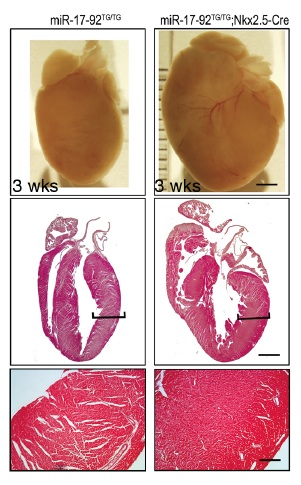
In mice, boosting amounts of a microRNA family called miR-17-92 led to dramatic enlargements of embryonic and postnatal hearts, with thicker ventricle walls.
Now, we have a potential therapeutic target to accomplish this: a family of microRNAs called miR-17-92 that regulates cardiomyocyte proliferation. In Circulation Research earlier this month, a team led by Kühn’s research colleague Da-Zhi Wang, PhD, demonstrates its potential.
“One of the major problems with the heart is that it cannot naturally regenerate,” says Wang. “The death of mature cardiomyocytes in pathological cardiac conditions and the lack of regenerative capacity of adult hearts are primary causes of heart failure and mortality.”
So Wang and his team took a closer look at how heart cells grow. They were interested in the miR-17-92 cluster, because it had been shown to promote cell proliferation in other studies.
Their research, in normal and damaged mouse hearts, produced several important findings:
- Deleting the miR-17-92 cluster from embryonic and postnatal mouse hearts sharply decreased cardiomyocyte proliferation.
- Adding more miR-17-92 than normal to embryonic, postnatal and adult hearts induced cardiomyocyte proliferation. In adult hearts, the additional miR-17-92 actually protected the heart from injuries resulting from a heart attack, or myocardial infarction.
- Certain members of the miR-17-92 cluster, such as miR-19, were required for and sufficient to induce cardiomyocyte proliferation in cell cultures.
These findings, Wang believes, “will allow us to identify specific targets for drug development to treat heart failure,” and could guide research on regeneration in other organs.
Next up for Wang and his team are tests in mice and larger animals to determine whether direct delivery of these miRNAs in the heart can prevent or reduce the risk of developing myocardial infarction or chronic heart failure.
“This is very exciting work and may lead to therapeutics that can replace or repair damaged hearts,” says David Clapham, MD, PhD, chief of the Basic Cardiovascular Research Laboratories at Boston Children’s Hospital. “If similar mechanisms exist in lung or brain, these tissues might also be regenerated after infection, pulmonary embolism or stroke.”
Editor’s note: For more information, or to learn about partnership opportunities related to this technology, please contact the Technology and Innovation Development Office at Boston Children’s by email or phone at (617) 919-3019.






